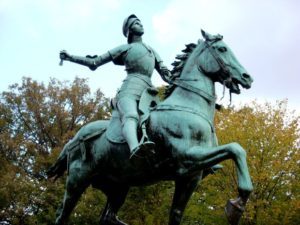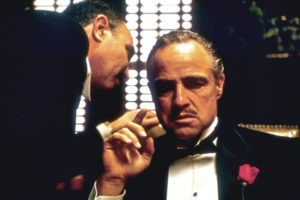Stavros Halvatzis's Blog, page 41
June 18, 2016
What is Storytelling?
 Storytelling, as Robert McKee succinctly tells us, is the creative demonstration of truth.
Storytelling, as Robert McKee succinctly tells us, is the creative demonstration of truth.
A story is the living proof of an idea, the conversion of idea to action. A story’s event structure is the means by which you first express, then probe your idea … without explanation.
The Moral Theme in Storytelling
This idea, I would further argue, must contain a moral premise – a guiding moral principle that traces the consequences of character actions in the story. We can also think of this as the theme of the story.
Think about the crime genre. What idea, or moral premise lies at its core? How about: Crime does not pay?
But how does the writer embed this theme? Hopefully not through trite and on-the-nose dialogue. Do not write:
“You see, Frank? I told you. Crime does not pay!”
Terrible.
Rather, show a character committing a crime, or crimes, then expose the consequences.
The television series, Breaking Bad is an example of powerful storytelling that exposes how crime, in this instance, manufacturing meth, draws in those directly involved to lie, betray and murder.
Additionally, great storytelling explores the theme or moral idea from several angles. The protagonist represents one angle. The antagonist another. The supporting cast of characters still more. The author’s judgment, arguably the defining angle, is revealed only at the end of the story when the theme is proved – when the protagonist, representing a specific moral idea, wins or loses the conflict to the antagonist.
In my novel, The Land Below, for example, the correctness or incorrectness of Paulie’s decision to leave his apparently safe existence in a converted underground mine, a decision which will result in his being banished from the community, can only be established at the end of the novel.
If things go well for Paulie and his followers, then the theme of the story might be: Courage, imagination and steadfastness lead to freedom. If things go badly, then the theme might be: daydreams and stubbornness lead to defeat.
As with all stories, the outcome can only be established at the end. It is only then that the reader can definitely say what the story has really been about.
Summary
Storytelling is the process of narrating events that prove a moral theme.
Tweet
The post What is Storytelling? appeared first on Stavros Halvatzis Ph.D..
June 11, 2016
Understanding Scene Sequences
 A scene does not exist in isolation from other scenes. It is organically connected to the overall network of scenes that makes up a story.
A scene does not exist in isolation from other scenes. It is organically connected to the overall network of scenes that makes up a story.
In Making a Good Script Great Linda Seger reminds us it is more useful to think of a scene as being a member of a scene sequence – scenes that are so tightly connected to one another that they create causal narrative blocks within the story.
These sequences might be chase scenes in a city that get progressively shorter until they end in a car crash or getaway; they may build up to the final explosion in The Guns of Navarone; they might culminate in two lovers reuniting as in When Harry met Sally.
In The fugitive the first sequence of scenes might be called murder and the sentencing. They form a tight causal unit and last eleven minutes in the film. The next sequence could be called the escape, leading to the train wreck. The sequence following that could be labeled after him and include the scenes of Deputy Sam Gerard starting the chase, culminating in Kimble arriving in Chicago.
And so on.
The point is that all these scenes are grouped together by cause and effect, or, at least, action and consequence, leaving little room for irrelevant, off-the-point action.
In my novel, The Level, for example, the protagonist, in the beginning of the story, finds himself bound to a sturdy chair in a pitch black room. To make matters worse he is suffering from amnesia and has no clue why he is in this situation.
Later, a mysterious woman in a burka appears to him from the darkness and unties him. She leaves him a series of clues he needs to follow in order to escape.
The story becomes a connect-the-dots mystery, driven by dangerous traps that threaten the protagonist’s every step. It may be argued that the entire story is driven by causally connected scene sequences, each of which reveals a part of the puzzle, leaving little room for boredom.
Summary
Organise your scenes into scene sequences in order to drive the action and maintain the pace in your stories.
Tweet
June 4, 2016
Emotions Bind Us to Stories
 ROBERT Frost, highlighting the importance of emotions, famously wrote: “No tears in the writer no tears in the reader.”
ROBERT Frost, highlighting the importance of emotions, famously wrote: “No tears in the writer no tears in the reader.”
Although he was referencing a specific emotion, it applies to a range of emotions solicited by great writing – compassion, awe, elation, fear, anxiety, jealousy, and the like.
The Importance of Emotions
Stories that evoke a range of emotions – emotions that are tested against the writer’s own experience – bind the reader to the characters of a story by soliciting identification, sympathy, and empathy in the reader.
Accomplished writers understand that such novels and screenplays are difficult to put down. The reader is compelled to keep turning the pages in order to discover how those emotions play out.
Emotions cross the boundaries of age, gender, race, and even species. Consider the following passage, taken from Margaret Geraghty’s The Novelist’s Guide, in which a character, Violet, tries to come to terms with the death of her beloved dog, Carey. Instead of the writer describing Violet’s feelings of sadness directly, she lets us experience these emotions vicariously through the technique of show-don’t-tell:
“When the vet had gone, Violet knelt down on the worn rug beside Carey’s basket. His was still, his mouth slightly open, one ear bent over like a rose petal, revealing the pink skin inside. He smelt a little. Nothing bad, just the way you’d expect an old dog to smell. […]
In the end, she […] went to run a bath. Cleanliness was next to Godliness. She’d always believed that. When the bath was full, she went back to Carey, gathered him in her arms, and gently, carefully lowered the stiff little body into the warm water. It was, she reflected, the first time that he hadn’t struggled.”
That last line in particular is a genuine tear-jerker, compacting all the years of love for her dog in one distinguishing moment.
Significantly, there is no abstract description of Violet’s sadness, her sense of loss. What we have instead is a concrete and specific scene that conveys immediacy by granting us access to Violet’s direct experience. Our hearts and minds jump back to a time when we, perhaps, had lost a beloved pet, helping to make Violet’s loss our loss.
This technique lies at the heart of creating deep and genuine emotion in the reader and is one of the secrets in welding the reader to the characters in our stories.
Summary
Use emotions to bind readers to the characters in your stories.
Tweet
May 28, 2016
Writing Great Point-of-View Characters
 WHAT makes for a great point-of-view character? In her book, The Novelist’s Guide, Margaret Geraghty offers us the following advice.
WHAT makes for a great point-of-view character? In her book, The Novelist’s Guide, Margaret Geraghty offers us the following advice.
A great point-of-view character is one whose problems fuel the story; the character who has the biggest emotional and physical stake in the story – the most to lose if things go belly up for her.
Writing Point-of-View
Such a character is at the center of the action. Passive characters who merely observe rather than act are not vehicles through whose hearts and bodies we want to experience the story. Imagine if Edge of Tomorrow‘s Major William Cage, played by Tom Cruise, was a mere observer to the alien invasion rather than a key figure in defeating it.
Point-of-view characters are the most interesting. Their thoughts, feelings and opinions are what the readers find most intriguing and absorbing.
A point-of-view character is the most complex. The Nostalgia of Time Travel‘s Benjamin Vlahos is such a character. Guilt, nostalgia, and longing, coupled with a powerful intellect have brought him to a stalemate. He can’t go back and he can’t move forward. Not unless he finds the solution that has eluded him for thirty years – prove that time travel to the past is possible.
Other point-of-view characters may appear deceptively simple, but only from the outside. In Hemingway’s, The Old Man and the Sea, the character of the old man appears seems straight forward. But his tenacity in holding onto the fish, even when all seems lost, speaks of a deeper reason.
The old man has a reputation of coming home empty handed from his fishing expeditions. No one wants to go out on his boat with him any more. He appears habitually unlucky and this has cast a shadow over him. It is something he needs to shake off if he is to hold his head up high again.
Interesting, complex, and emotionally invested characters who have the most to lose in a story, then, are great candidates for the point-of-view mantle.
Summary
Writing point-of-view characters whose emotions and actions drive the story forward makes for absorbing stories.
Tweet
May 21, 2016
What Drives Your Protagonist?
 CONTINUING my exploration of Robert Mckee’s, Story, I highlight an important technique: How to make your protagonist more engrossing. This entails that I talk about the tension between want and need.
CONTINUING my exploration of Robert Mckee’s, Story, I highlight an important technique: How to make your protagonist more engrossing. This entails that I talk about the tension between want and need.
The Tension driving your Protagonist
The protagonist is a willful character. His pursuit of his desire is relentless. It is also the outward manifestation of an unconscious inner conflict. It stems from what he believes he wants in life.
In The Land Below Paulie’s desire is to reach the surface in search of wonder. In The Nostalgia of Time Travel it is Benjamin’s obsession with solving an intractable mathematical equation. In Scarab it is Jack’s desire to undo Emma’s death. Often, clear and conscious desires are enough to drive the story forward.
But the greatest stories do not only pit the protagonist against external obstacles to desire. They also pit him against himself.
They do this by infusing him with an unconscious desire that is at odds with his declared want. The result is an inner conflict which is resolved only when he realises that his want is inferior to his need.
Indeed, it is this very recognition that is the final proof that the protagonist has grown. It indicates that he has learnt from his mistakes. It heralds his final readiness to face and defeat the antagonist at the level of external action.
In The Nostalgia of Time Travel, Benjamin is able to move on from a life of regret and stasis only when he realises that his salvation lies not through mathematical solutions to impossible problems but in self-forgiveness through art. In Scarab, Jack is able to save the woman he loves through sacrifice – by walking away from the relationship he so desperately desires.
In these, and other stories, it is the tension lurking beneath what the protagonist wants and what he needs that fascinates readers.
Summary
The tension between what a protagonist wants and needs is the engine of conflict in the protagonist.
Tweet
The post What Drives Your Protagonist? appeared first on Stavros Halvatzis Ph.D..
May 14, 2016
Conflict, Complication and Complexity in Stories
 IN HIS book, Story, Robert McKee reminds us that conflict arises the moment the protagonist steps out of the Inciting Incident and heads towards the turning point at the end of act one.
IN HIS book, Story, Robert McKee reminds us that conflict arises the moment the protagonist steps out of the Inciting Incident and heads towards the turning point at the end of act one.
Act two, the longest act of any story, is held together by conflict, complication and complexity. Every obstacle the protagonist encounters in trying to attain the goal, is complicated by these three aspects.
But what is the difference between complication and complexity? Aren’t they one and the same thing?
Complexity from Conflict and Complication
Complexity, according to McKee, results from the deepening interaction between three layers of conflict:
Inner
Personal
Extra-personal
In Kramer Vs. Kramer, for example, Kramer, whose wife has left him and his son, is torn by inner doubt. He loves his son, but is he in over his head? Can he bring up the child on his own?
There is also personal conflict. The boy is acting-up. He is terrified that he’ll starve without his mother to feed him. Kramer has a hard time pacifying the hysterical child.
Finally, he experiences extra-personal conflict. The kitchen is a dangerous, alien place for the inexperienced Kramer. He does his best to feign confidence. Things, however, degenerate rapidly as he tries to fry eggs for his son.
As the ill-equipped father fights the forces that threaten to defeat him, comedy turns into pathos. The result is one of the most memorable scenes in the film.
In my recent novella, The Nostalgia of Time Travel, a middle-aged theoretical physicist, too, has to battle complex internal and external conflicts in order to survive. Years of deep-seated guilt, an almost intractable mathematical problem, and an approaching category-five cyclone threaten his life. Together these conflicts create complexity that makes for engrossing reading.
Summary
Complication rises to the level of complexity when a character experiences inner, personal, and extra-personal conflict.
Tweet
The post Conflict, Complication and Complexity in Stories appeared first on Stavros Halvatzis Ph.D..
May 7, 2016
How to Make Your Story Universal
 EVERY great story is both particular and universal. Being rooted in a local context paradoxically allows it to reach beyond its social and cultural boundaries. In his book, Story, Robert Mackee refers to the process by which a story becomes universal as symbolic ascension.
EVERY great story is both particular and universal. Being rooted in a local context paradoxically allows it to reach beyond its social and cultural boundaries. In his book, Story, Robert Mackee refers to the process by which a story becomes universal as symbolic ascension.
Like the images in our dreams, symbols permeate our unconscious mind. They deepen our experience of a story in ways that are not at once apparent.
Done in a crude way, we immediately recognise these images as mechanical devices, destroying their effect. Slipped in gradually, skillfully and surreptitiously, however, they move us profoundly.
Making Stories Universal through Symbolism
Symbolic ascension works in this way: At first the settings, incidents and specific actions of characters in a story represent only themselves – they are denotative or literal in meaning. But as the story progresses they acquire greater significance. They acquire connotative or figurative meaning. By the end of the story these very same settings, incidents and actions come to stand for universal ideas.
In The Deer Hunter, the protagonist, Michael (Robert De Niro) progresses from a beer-drinking factory worker to a worrier – the hunter of the film’s title. A man who kills.
But the film shows that if you keep killing you eventually will turn the gun on yourself – as does Nick (Christopher Walken).
The death of Nick precipitates a crisis in Michael. Armed, and in camouflage, he ascends to a mountain top where he spots a magnificent elk emerging from the surrounding mist. The setting resonates with significance harking back to Moses receiving the transformative knowledge of the Ten Commandments on Mount Sinai.
The action (the ascension), and the setting (the mountain), are symbolically significant. But they are also literal events. It is this effortless duality that gives the story its enduring power.
In my own novel, The Land Below, life in a converted underground mine (the sanctuary of the only humans to have survived a cataclysm), becomes increasingly claustrophobic for its young protagonist, Paulie.
He dreams of the open resplendent spaces filled with grass and waterfalls that he has only seen in books. His decision to climb to the surface, against the warnings of his elders, is a symbolic rejection of fear and ignorance. It represents his desire for knowledge. His actual physical journey to reach the surface has therefore acquired symbolic meaning.
Summary
Symbolic ascension is the process by which seemingly ordinary and specific settings, actions and events acquire universal meaning.
Tweet
The post How to Make Your Story Universal appeared first on Stavros Halvatzis Ph.D..
April 30, 2016
The Gap in Stories

Stories and the gap
IN his influential book, Story , Robert McKee explains a mechanism that is central to understanding the protagonist’s action in stories. He calls this mechanism the gap.The gap refers to the distance between the protagonist’s subjective evaluation of the achievability of the goal and its objective evaluation by the external world.
From the protagonist’s point of view the paths to the goal seem initially doable and efficient. But as he initiates action the reaction of the world creates a resistance which is proportional to the effort expended.
Extending the Gap in Stories
The more the effort the more resistance he encounters. The result is that his initial evaluation of the goal, too, begins to change. Inner and personal conflicts combine with external conflicts to open a gap between his action and its effectiveness.
This constant expansion of the gap changes the protagonist. He begins to doubt his ability to achieve success. He starts questioning his values and resources. He is forced to take more desperate action, take more risks, in order to try and reverse each failure.
Without a gap between expectation and result in stories, without increasing risk, there would be no tension and conflict. There would be no drama.
The gap between intention and result, therefore, is the space in which interesting and engrossing conflicts play themselves out. Additionally, the gap is not only the generator of inner and outer conflict, it is the motivator of change in the protagonist.
Summary
The gap in stories is the space that separates action and reaction, intention and result, emanating from the protagonist’s pursuit of the goal.
Tweet
The post The Gap in Stories appeared first on Stavros Halvatzis Ph.D..
April 23, 2016
How to Write Great Dialogue
 STORY consultant Linda Seger reminds us that great dialogue is an indispensable part of any enduring story.
STORY consultant Linda Seger reminds us that great dialogue is an indispensable part of any enduring story.
Great dialogue has rhythm, context and veracity. It conveys character through subtext and promotes plot through subtlety, ingenuity and compression.
Making Dialogue Memorable
Sometimes a line of dialogue rises to the status of theme and serves to sum up the premise of the story. At its best, it becomes a meme, an item in our menu of commonly used expressions.
In my classes on storytelling, I urge my students to come up with several supercharged lines in their story that not only capture some important aspect of a character, but that also sum up or, at least, highlight important features of the tale.
Such snippets of dialogue increase their power through repetition, not only within the story itself, (the line is repeated by the same or other characters), but also extradigetically, through the viewers and readers who quote it in their everyday lives.
Who can forget these immortal lines?
1. “Go ahead, make my day.”
2. “I have a feeling we’re not in Kansas any more.”
3. “Life is like a box of chocolates.”
4. “I’ll be back.”
5. “I love the smell of napalm in the morning.”
6. “I’m not bad. I’m just drawn that way.”
7. “I’m going to make you an offer you can’t refuse.”
Great dialogue echoes, sings, resonates, surprises and excites. Like great music, it keeps replaying itself over and over in our minds.
How many of the lines above can you place? Check below for the answers.
Summary
Great dialogue performs many functions in a story. At its best, it becomes a meme that spreads throughout society, immortalising its source.
1. Dirty Harry
2. The Wizard of Oz
3. Forrest Gump
4. Terminator
5. Apocalypse Now
6. Who Killed Roger Rabbit
7. The Godfather
If you’d like to learn more about my books and background please visit my Amazon author’s page by clicking on this linked text.
Tweet
The post How to Write Great Dialogue appeared first on Stavros Halvatzis Ph.D..
April 16, 2016
Dazzling With Language in Stories
 There are many things that go into crafting great stories.
There are many things that go into crafting great stories.
Some aspects are hidden from initial view. They are glimpsed only as the story progresses. They exist in the tension between character, theme, setting. They relate to pace, tone, mood, insight.
Such tensions play off against one other eventually kindling a fire that dazzles. Others, such as arresting physical and psychological descriptions through simile and metaphor, are immediately apparent.
No two stories are the same. The narrative relationships within each are too rich and varied for that.
A gifted writer knows when to dazzle us with her exotic yet precise word choice and when to use a subdued vocabulary in order to let something else shine through. A gifted writer is like a gifted conductor, moulding, pacing, coloring every note to greater purpose, now drawing our attention to one voice, now to another.
Dazzling Stories
Today I want to point to what is perhaps the easiest skill to spot – the virtuoso use of language that grants us crucial insights about life (and death).
Examples in stories are as numerous as they are varied, so my choice is a personal one. I’m referring to the many arresting lines from Paul Harding’s first novel, Tinkers, which won the Pulitzer for literature in 2010. The book has not only had a lasting effect on me, but has inspired me to try my hand at a more literary style, resulting in my recently released novella, The Nostalgia of Time Travel.
There is something magical about Harding’s use of language that transcends space and time and makes it truly universal. He starts his book with the lines:
“FORGE WASHINGTON CROSBY BEGAN TO hallucinate eight days before he died. From the rented hospital bed, placed in the middle of his own living room, he saw insects running in and out of imaginary cracks in the ceiling plaster.”
A little later, Harding gives us this surreal description of Forge’s world tearing open as he prepares for death:
“The roof collapsed, sending down a fresh avalanche of wood and nails, tarpaper and shingles and insulation. There was the sky, filled with flat-topped clouds, cruising like a fleet of anvils across the blue. George had the watery, raw feeling of being outdoors when you are sick. The clouds halted, paused for an instant, and plummeted onto his head.
The very blue of the sky followed, draining from the heights into that cluttered concrete socket. Next fell the stars, tinkling about him like the ornaments of heaven shaken loose. Finally, the black vastation itself came untacked and draped over the entire heap, covering George’s confused obliteration.”
This is exceptional, packed writing. How can one not want to read more?
Although I do not presume to claim a place amongst such illustrious company, passages such as the ones quoted above inspired me to come up with my own insights about growing older and our need to reconcile our life with our past mistakes. Here’s my protagonist, The Nostalgia of Time Travel‘s, Benjamin Vlahos, pleading for a second chance to get life right:
“Sometimes, I wonder what it must be like to be a subatomic particle existing for the briefest of moments; all the joy and pain of birth and death compressed between the two staccato ticks of that relentless hand.
At other times I imagine a scaled-down version of myself, living on the surface of the watch, fighting against the perpetual ticking of that fearsome engine. I imagine gripping the watch’s hands in my bleeding fists, my arms extended, my body and head thrust forward, my legs bent and wide apart, until I stop the hands from ticking and force them back, rotating them anti-clockwise, back to that moment on the Sydney pier when I stopped to buy my last pack of cigarettes, while Miranda stood on the pavement smiling brightly back at me.”
Ultimately, Benjamin, despite his being a theoretical physicist, opts for art, not science, as a way of understanding life’s vicissitudes:
“Isn’t everything worth knowing squeezed inside the kernel of a story? All that’s ever been written, sang and spoken, pressed into a single pearl? The story is our raft when old age casts us out to sea; the logs are the memories, the ropes are the love and kindness we have shared. Can my equations ever be that?”
Summary
Use powerful but appropriate metaphors In your stories to immediately capture your reader’s attention.
Tweet
The post Dazzling With Language in Stories appeared first on Stavros Halvatzis Ph.D..



